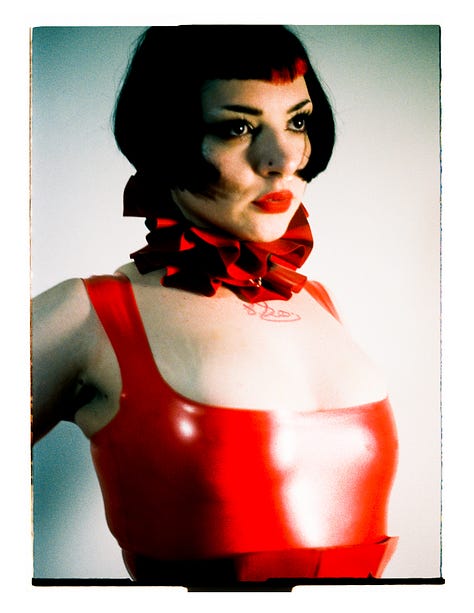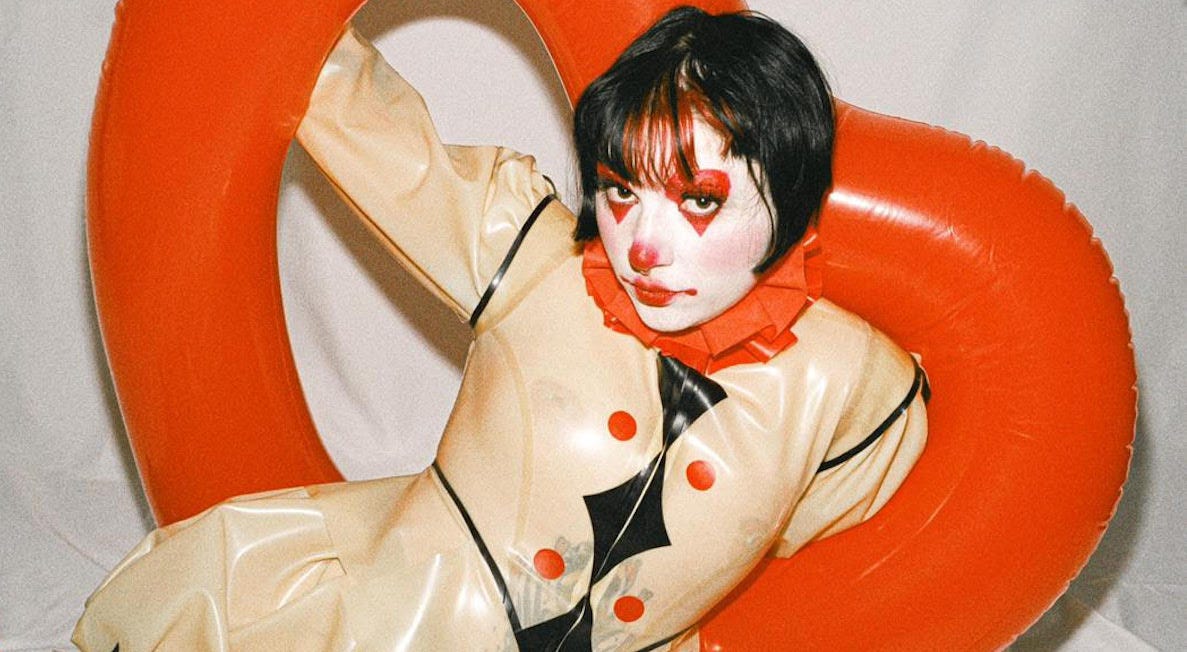Cherry Velour's transformational performance art of pain
The artist uses their practice to shift public perception of kink and move beyond the capitalistic co-opting of BDSM aesthetics.
Welcome to SHAGGERS, an interview series speaking to creative practitioners expanding sexual culture.
So many of the rituals of BDSM have been documented via the flash of a camera — but while still imagery can capture a mood or a moment, it can rarely distil the intricate dynamics of pleasure, pain, trust and power which inform the intimate relations within the kink world.
The work of Cherry Velour, a Palestinian-American artist currently based in the UK, brings these vivid exchanges to life through an expansive performance practice. Ranging from playful kink clowning to durational BDSM performance, her work confronts lazy stereotypes about erotic subcultures while pushing the audience to recontextualise their preconceptions of sexuality, safety and fulfilment.
Velour’s recent performance Red Thread to Hold stood out for its technical precision and emotional intensity, presenting body suspension not as spectacle, but as a rigorous and tender negotiation of trust. Few artists working in the UK right now are engaging BDSM frameworks with such emotional depth, physical risk, and intentional relationality. The work foregrounds Cherry’s gift for building spaces where vulnerability is neither ornamental nor hidden, but actively held.
Below, I speak to Velour about how her formation in video games has helped inform the world-building of her performance work, and the role of neurodivergence within her practice.
What's your creative background?
I have a BFA in Digital Art and Animation from a technical university called DigiPen and my day job for the past seven years has been as an artist in the video game industry. I’ve finally left that industry, and had been wanting to for years, but for a long time it was the only thing that granted me a visa.
The biggest crossover between that professional work and my current practice —which is performative, relational, and deeply embodied — is world-building and play. Both games and performance art create alternate realities with their own rules. You step into them to feel something you can’t feel elsewhere.
Narratives run through both. You create a little universe to move through, and in that universe, you get to change shape. I think that transformation is the red thread through all of my creative practice.
“Both games and performance art create alternate realities with their own rules. You step into them to feel something you can’t feel elsewhere.”
How would you describe your practice?
First and foremost, I see myself as a collaborator. I work best in relation-to, in trust, in co-creation. I use the frameworks and methodologies of BDSM as the structure for most of my work, so relationality isn’t just a theme, it’s core to the work.
Practically, I mostly do performance art. I explore transformation, autonomy, surrender, and the shifting boundaries of identity. My practice often uses pain — physical, emotional, or symbolic — as a vessel for vulnerability, presence, and connection. There’s often blood involved, if the venue allows. But it’s not as scary as it sounds! There’s always an undercurrent of joy and playfulness, you may not always see it but you can always feel it.
A lot of my work is about power. Not dominance in the flat sense, but the power that lives in tenderness, in choosing to give yourself over, in the consensual exchange of autonomy. In letting someone else hold you while you come undone, and sometimes that “someone else” is another part of yourself, or even your own physical body. I’m interested in the kinds of spaces where something raw, vulnerable, and real can unfold.
How do you use your work to reframe ideas around kink?
My work involves kink, but what’s more central are the frameworks of BDSM itself: the dynamics, the structure, the care. I’m less interested in what a kink looks like than in what it means. For example, a scene might involve masochism, but it’s really about the relationship; to the self, to the other, to the audience, to pain, to power.
How I communicate about kink has shifted as public engagement with kink has shifted. In my earlier work, I used a lighthearted, clownish persona during a time when kink was more heavily stigmatised. People often saw masochists as victims, or sadists as abusers. I was tired of seeing kink only represented in shadowy dungeons with serious-looking dominants. I wanted to show the playfulness, the joy, the softness that’s rarely seen.
In more recent years, kink aesthetics have been co-opted by capitalism and popular media. It’s become less stigmatised, but also more sterilised. The aesthetics are desirable (sellable) — a pretty girl getting spanked, or a glamorous latex-clad mistress — but there’s still a hierarchy of what’s acceptable.
What’s missing is an understanding that BDSM is not merely an activity, but a framework. Within that, anything consensual can be an act of care. If you don’t understand that, you’ll just see the action and project your own meaning onto it.
So my practice has shifted. I now work more with what we call ‘edge play’: things that push the boundaries of our physical and emotional limits such as intense CNC fantasies, violence, fear, or heavy masochism. I show that these intensities are simultaneously acts of deep care and love. I want to push the viewer to rethink what violence is, if it isn’t inherent in the act itself.
Because if violence is not defined by the act, but by its context and intent, then maybe we need to rethink how we read images. What are we really reacting to: the scene itself, or what its symbols evoke in us?



Your practice also explores neurodivergence, what does this look like in your work and why is this an important conversation in the kink community?
I have pretty intense ADHD, and a traumatic childhood that made dissociation a coping strategy. I learned to survive by leaving my body, and to this day, I’m rarely ever present. And presence, for me, requires safety.
The first time I ever felt truly present was during a heavy impact scene. The whole framework — the negotiation, the structure of play, the container of aftercare — combined with the intensity of the physical experience, ripped me into my body. For the first time, my mind was quiet. I had a focal point. I didn’t need to make decisions. My executive function could rest. I was just processing sensation, endorphins, and being held.
Kink is a framework that holds me. It allows me to put down the impossible labour of functioning in a neurotypical world. I don’t have to make decisions. I don’t have to mask. I don’t have to be productive. I just get to be held, or to hold.
This is mirrored in my practice. The structure of the performance space holds me. The visceral intensity forces presence. There’s a moment when I am fully in my body, and I know my singular purpose. The audience shares in that clarity. Their role is equally simple; to witness, to be with me, to feel through me.
This is especially important in the kink community, because as many kinky folks would confirm, a huge amount of us are neurodivergent. Kink provides what many of us crave; structure, ritual, creativity, repetition, rhythm. It offers play without judgment. It gives us space to be messy, to be strange, to be fully ourselves. We already experience the world in ways that often other us — it’s no surprise we seek out alternative structures for intimacy, play, and connection.
What is the role of care and collaboration within your practice?
This is the real meat of my work. I believe in love above all else, and that love is created through care and collaboration. Relationships matter so much to me: tending to them and nourishing them, like a garden.
The process of collaboration (much like BDSM) is a dance of genuine care, curiosity, and consent, and a playground for transformation and self-discovery. We put all this work in to create a space built on trust where your varied perspectives are considered and valued, where your boundaries make the foundation, and where your creative and playful self can expand and flourish.
When I’m suspended by hooks through my skin, I can only do that because the person who pierced me has taken time to care for me, my body, my mind — and I for them. My body cares for me too, in how it literally holds me, how it heals, how it communicates. Pain is a language our bodies use to communicate with us. When you stop framing pain as an inherently bad experience to be avoided, and start opening up that dialogue, start speaking that language, start communicating back to your body — real transformation can take place. It’s beautiful when you start to see everything through the lens of care and collaboration.
“Kink is a framework that holds me. It allows me to put down the impossible labour of functioning in a neurotypical world”
Where do you hope to take your practice in future?
I want to start working more directly with my Palestinian identity. I’ve avoided it for a long time out of shame, out of low self-worth, out of inherited trauma. But now, more than ever, I feel a responsibility to face it, and to work with the pain, fear, and shame that comes with it.
I think both BDSM and art, at its best, are spaces where transformation becomes possible. We can build new relationships to pain, to fear, to power. It gives us these incredible tools which we can then apply to any aspect of our lives. I want to use my practice to enter into that kind of dynamic with myself, and to transform how I relate to my identity, and to my lineage.





